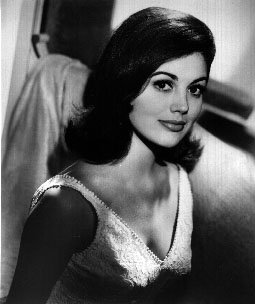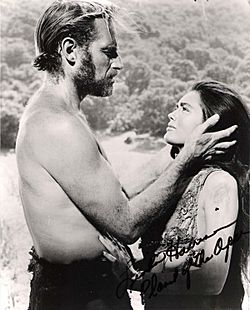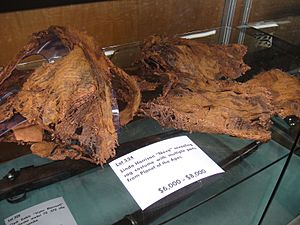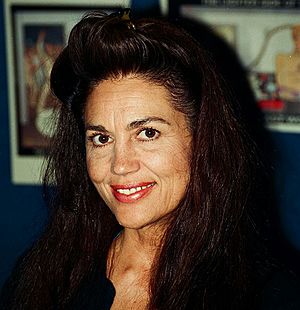Linda Harrison facts for kids
Quick facts for kids
Linda Harrison
|
|
|---|---|

Harrison ca. 1966
|
|
| Born |
Linda Melson Harrison
July 26, 1945 Berlin, Maryland, U.S.
|
| Other names | Augusta Summerland |
| Education | Stephen Decatur High School |
| Occupation | Actress |
| Years active | 1966–present |
|
Notable work
|
Nova (Planet of the Apes) Beneath the Planet of the Apes Batman |
| Spouse(s) | |
| Children | 2; including Dean Zanuck |
Linda Melson Harrison (born July 26, 1945) is an American actress. She is best known for playing Nova in the classic science fiction movie Planet of the Apes (1968). She also appeared in the first sequel, Beneath the Planet of the Apes. Later, she had a small role in the 2001 remake of the original movie. Linda Harrison was also a regular on the TV show Bracken's World from 1969 to 1970. She was married to film producer Richard D. Zanuck, who produced movies like Jaws and Charlie and the Chocolate Factory. Her youngest son, Dean Zanuck, is also a film producer.
Contents
Early Life and Acting Dreams
Linda Melson Harrison was born in Berlin, Maryland. She was one of five daughters. Her father was a nurseryman, and her mother was a beautician. Linda was the middle child.
Her mother noticed Linda's talent early on. When Linda was five, she started taking ballet and acrobatics classes. By age six, she was already performing on stage and loved it. When she was eleven, Linda won first prize in a talent contest for her acrobatic performance. Six years later, she won the "Miss Delmarva" beauty contest.
Linda attended Stephen Decatur High School in Berlin. She was a skilled acrobatic dancer. She also dreamed of becoming an actress and a star. Her plan was to win beauty contests, then go to California to be discovered.
After high school, Linda briefly attended the University of Maryland, College Park. She also tried a secretarial school but found it boring. She then moved to New York with her oldest sister, Kay. Linda found some success as a model there. However, she missed Maryland and returned home less than a year later.
Following her plan, she entered and won the 1964 Miss Delmarva beauty pageant. This led her to the Miss Maryland pageant, which she also won. As Miss Maryland, she traveled to Long Beach, California, for the Miss America contest in June 1965. She hoped to win, but she was the first runner-up instead. She was very disappointed.
However, her striking looks caught the eye of Mike Medavoy, a talent agent. He told her she should be in movies. In August 1965, she got a "personality test" at 20th Century Fox. This led to a 60-day agreement with the studio. During this time, she studied with an acting coach.
In October 1965, Linda attended a movie premiere where she met Richard D. Zanuck. He was a Vice President at Fox. They started dating, and her acting career became closely linked with their relationship.
Starting Her Acting Career
After meeting Zanuck, Linda signed a seven-year contract with Fox in November 1965. She joined the studio's Talent Training School. This school helped young actors and actresses learn their craft. Other students included Jacqueline Bisset and James Brolin. Linda took drama, speech, fencing, and dance classes. She also worked with a speech coach to lose her Maryland accent.
Linda's first acting job was a small role as a "Biker Chick" in a TV pilot called Men Against Evil, which became the show Felony Squad. She had only three words to say: "Go, man, go!" She was excited to be working in Hollywood.
Next, she appeared briefly in the Batman TV series in March 1966. She played one of three high school cheerleaders. Even for a few seconds on screen, she worked hard with her dance coach.
Planet of the Apes Beginnings
Soon after her Batman appearance, Linda filmed a test scene for a movie based on the book Monkey Planet, which later became Planet of the Apes. Zanuck wanted to show that the movie could be made. In this test, Linda wore ape makeup and played Zira, a role later played by Kim Hunter. Her acting classmate, James Brolin, played Cornelius.
Linda later said she thought the studio always had her in mind for the role of Nova. She found the ape makeup process difficult because she had to lie still for a long time while plaster was put on her face. The makeup took about three hours.
Even though the ape makeup test was good, the studio initially rejected the Planet of the Apes project.
Early Movie Roles
In May 1966, Linda made her first movie appearance in The Fat Spy. It was a low-budget comedy. Her next movie was the Jerry Lewis comedy Way...Way Out. She played an astronaut arguing with her husband, played by James Brolin.
After that, Linda appeared in a short test segment for a possible Wonder Woman TV show. She played a glamorous reflection of Wonder Woman. This test did not lead to a TV series at the time.
Linda then appeared in A Guide for the Married Man (1967). She played "Miss Stardust," a young woman with a blonde wig. She described her part as "fun" because it took her "all over the world." She wore many costumes for her five-minute scene.
Becoming Nova in Planet of the Apes
The filmmakers considered other actresses for the role of Nova in Planet of the Apes. However, Richard Zanuck suggested they test Linda Harrison. The director and producer met with her and thought she was a good fit.
Linda said that for her role as Nova, she thought about how animals would act, moving and reacting from fear. This was what the director wanted. After her test, she was hired for the role that would make her famous. The producer, Mort Abrahams, found her very cooperative and hard-working. She was always on time and interested in everything.
Filming for Planet of the Apes began on May 21, 1967. The first scenes were shot in Page, Arizona. Linda found working in the desert "beautiful." She was amazed at how the whole production, like a small town, was set up there.
Linda worked closely with Charlton Heston, who played Taylor. Since it was her first big movie, Heston helped her learn how to act for the camera. He taught her how to pose and move. Linda said Heston treated her kindly and was a gentleman. She also felt that the other experienced actors helped her because she was new to acting.
One idea for the movie was that Nova would be pregnant. Some scenes were even filmed showing this. However, these scenes were later removed from the movie. The studio felt it would distract from the ending.
After filming in the desert, production moved to Malibu Creek State Park in Los Angeles. The "Ape City" set was built there. Linda recalled it was very hot. The final scenes were filmed on the coast. Linda's character, Nova, was the only human to see Taylor's reaction when he discovered the ruined Statue of Liberty.
Linda's favorite scenes were shot at the coast. She enjoyed riding a horse with Heston.
Planet of the Apes was released in February 1968 and was a huge success. Linda was introduced as a new star in the movie's opening credits. Audiences were impressed by her look, even though her character had no spoken lines. The movie's success led to four sequels, a cartoon series, a TV series, and later remakes.
Linda Harrison attended a 30th-anniversary screening of Planet of the Apes in 1998. The film was also added to the National Film Registry in 2001, meaning it is considered important to American culture.
Beneath the Planet of the Apes
Linda Harrison played Nova again in the first sequel, Beneath the Planet of the Apes. She felt this movie was not as good as the first one. It had a smaller budget and a different director.
Neither Charlton Heston nor Kim Hunter wanted to make another Apes movie at first. Linda was also unsure because she was engaged to Richard Zanuck and less focused on acting. However, she felt she had to do it since it was a sequel.
Her role as Nova was expanded slightly, but her character still had very few lines. The director, Ted Post, said Linda was cooperative but needed a lot of guidance because she was still new to acting. He had to create actions for her character to make her fit into the story.
Linda's co-star, James Franciscus, remembered her as a "joy to work with." He recalled a risky scene where they rode a horse without a saddle or reins. Linda was nervous, but she was brave and did the scene. Linda said she had a lot of fun on the second Apes movie, finding it more relaxed than the first.
Bracken's World and Later Career
While filming Beneath the Planet of the Apes, Linda was cast in the NBC TV series Bracken's World. She played Paulette Douglas, a young aspiring actress. She had to quickly switch from silent acting to remembering lines. The show was canceled after its second season.
After Bracken's World, Linda's contract was ended. She later sued for wrongful termination. The lawsuit was settled out of court.
In 1974, after a break, Linda tried to restart her acting career. She wanted a role in the movie Jaws, but the director chose another actress. As a consolation, she got a part in Airport 1975 as Gloria Swanson's assistant. For this movie, she used the name "Augusta Summerland."
After Airport 1975, Linda guest-starred on several TV shows, still using the name "Augusta Summerland." In the 1980s, she went back to acting school. Her former husband, Richard Zanuck, and his new wife saw her perform. They offered her a part in their upcoming movie, Cocoon. She played Susan, a role she repeated in the 1988 sequel, Cocoon: The Return.
Recent Work
In 1990, Linda moved back to Berlin, Maryland, and opened a shop. A few years later, she returned to Los Angeles to be closer to her sons. She got a real estate license.
In 1995, she had a small role in the movie Wild Bill. In 1998, she appeared as herself in a TV documentary called Behind the Planet of the Apes, which was about the making of the Planet of the Apes films.
In October 1998, Linda attended her first science fiction convention. She found it very rewarding to meet fans who appreciated her work. She became a regular at Planet of the Apes conventions. In 2001, she had a small role in Tim Burton's remake of Planet of the Apes. She played a "Woman in Cart," but most of her scenes were cut.
In 2013, Linda began filming Midnight Massacre, a thriller where she was also an executive producer and co-star. The movie was released on December 15, 2023.
Awards and Recognition
In 2008, for the 40th anniversary of Planet of the Apes, Linda Harrison traveled to Spain. On October 11, she received the Maria Honorifica award at the Festival Internacional de Cinema Fantàstic de Catalunya. This award recognized her career in film.
Film and Television Roles
Films
| Year | Film | Role |
|---|---|---|
| 1966 | The Fat Spy | Treasure Hunter |
| Way...Way Out | Peggy | |
| 1967 | A Guide for the Married Man | Miss Stardust |
| 1968 | Planet of the Apes | Nova |
| 1970 | Beneath the Planet of the Apes | Nova |
| 1974 | Airport 1975 | Winnie (credited as Augusta Summerland) |
| 1985 | Cocoon | Susan |
| 1988 | Cocoon: The Return | Susan |
| 1995 | Wild Bill | Madam |
| 2001 | Planet of the Apes | Woman in Cart |
| 2022 | Midnight Massacre | Quinia Brutus |
Television
| Year | Show | Episode | Role |
|---|---|---|---|
| 1966 | Men Against Evil | Pilot | Biker Chick |
| Batman | The Joker Goes to School | Cheerleader II | |
| He Meets His Match, The Grisly Ghoul | |||
| 1967 | Wonder Woman: Who's Afraid of Diana Prince? | Short | Wonder Woman – Reflection (uncredited) |
| 1969 | The Tonight Show Starring Johnny Carson | Wednesday, November 19, 1969 | Herself |
| 1969–1970 | Bracken's World | 41 episodes | Paulette Douglas |
| 1975 | Barnaby Jones | "The Alpha Bravo War" | Dori Calder (credited as Augusta Summerland) |
| 1976 | Switch | Death Squad | Jill Martin (credited as Augusta Summerland) |
| 1977 | Barnaby Jones | The Damocles Gun | Jan Redbow (credited as Augusta Summerland) |
| 1998 | Behind the Planet of the Apes | TV documentary | Herself |
| 2014 | Inside Edition | Episode #25.221 | Herself |
See also
 In Spanish: Linda Harrison para niños
In Spanish: Linda Harrison para niños




